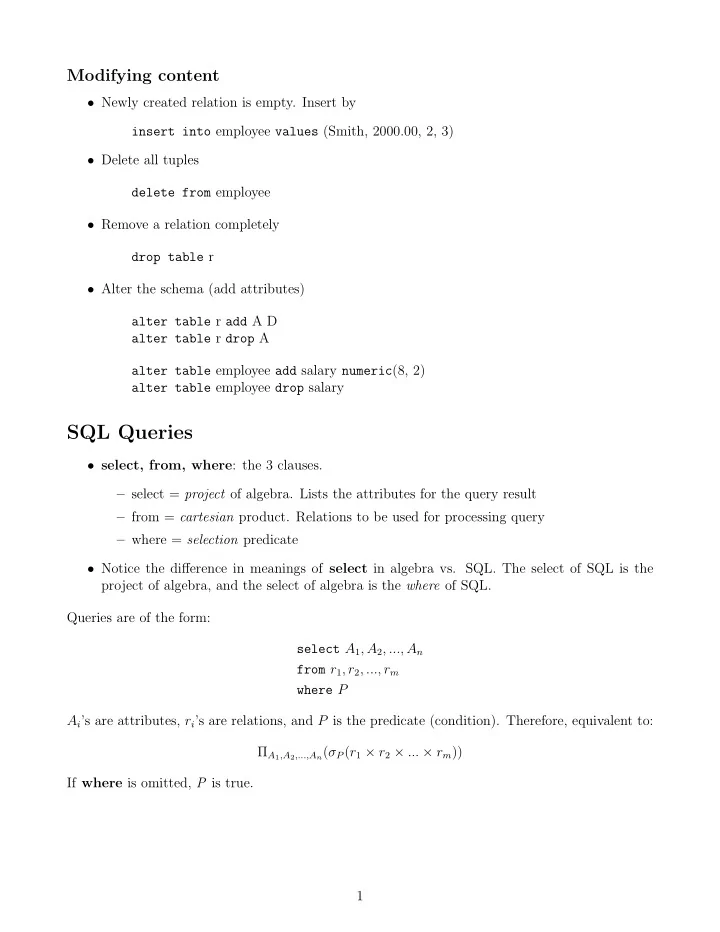

Modifying content • Newly created relation is empty. Insert by insert into employee values (Smith, 2000.00, 2, 3) • Delete all tuples delete from employee • Remove a relation completely drop table r • Alter the schema (add attributes) alter table r add A D alter table r drop A alter table employee add salary numeric (8, 2) alter table employee drop salary SQL Queries • select, from, where : the 3 clauses. – select = project of algebra. Lists the attributes for the query result – from = cartesian product. Relations to be used for processing query – where = selection predicate • Notice the difference in meanings of select in algebra vs. SQL. The select of SQL is the project of algebra, and the select of algebra is the where of SQL. Queries are of the form: select A 1 , A 2 , ..., A n from r 1 , r 2 , ..., r m where P A i ’s are attributes, r i ’s are relations, and P is the predicate (condition). Therefore, equivalent to: Π A 1 ,A 2 ,...,A n ( σ P ( r 1 × r 2 × ... × r m )) If where is omitted, P is true. 1
select clause Query: Find the names of all departments: select dept name from department Note: Rel. algebra: mathematic = ⇒ really strict about sets. Therefore, no duplicate values (tuples) appear as a result of an expression/operation. Reality: duplicate elimination is time- wasting. So, SQL etc. allow dupe tuples in relations (but of course not for a col. which is primary key) and for result of expressions . So, there maybe dupe dept name entries. Otherwise: select distinct dept name from department Redundant: select all dept n ame from department “*” = ⇒ all attrbts. select ∗ from department or select department. ∗ from department select may include arthmtc: +, -, /, * select name, salary ∗ 1 . 1 from employee 2
where clause Gives the predicate. Query: Employee name with salary > 2000 and work in department with id=3 select name from employee where salary > 2000 and dept id = 3 Also, between comparison operator: select name from employee where salary between 2000 and 3000 Also, not between . from clause Does CProduct of all relations in clause. Since Join = CP + select + project = ⇒ easy to do this in SQL. For e.g., “Find the names of all employees who are in a team and their team names.” select name, team name from employee, team where employee.team id = team.team id More complicated Q: “Find the names of all employees and their team names who are in a team that has at least three wins.” select name, team name from employee, team where employee.team id = team.team id and team.wins > 3 Rename operation • Can rename relations and attributes . = ⇒ appears in both select and from . • old name as new name • Cases in which can’t derive attrbt. names w/ from clause easily: – 2 relations in from w/ same attrbt. name – w/ arithmetic operatns 3
– may just wanna change names Using rename in select : select name, team name as strong team from employee, team where employee.team id = team.team id and team.wins > 3 Tuple variables • Get TV’s by renaming relations in from . • Common in comparing attrs. in same relation: – e.g. Query: Name of teams who have more wins than at least one other: select T.team name from team as T, team as S where T.wins > S.wins String operations • Single quotes for strings: “ ‘ ”; Case sensitive • like for pattern matching – % : matches any subtring : matches any character – ∗ ‘Day%’ matches ‘Dayton’, ‘Days’, ‘Day’ ‘Day 12’ ∗ ‘%Day%’ macthes ‘12th Day’ , ToDay , Day ∗ ‘%Day ’ matches ‘24 Days’ ∗ ‘ ’ matches a string with exactly 3 chars. ∗ % matches a string with at least 3 chars. select name from employee where name like ‘%Main%’ – Use \ to escape % and in strings – not like operator to search for mismatches . 4
Recommend
More recommend